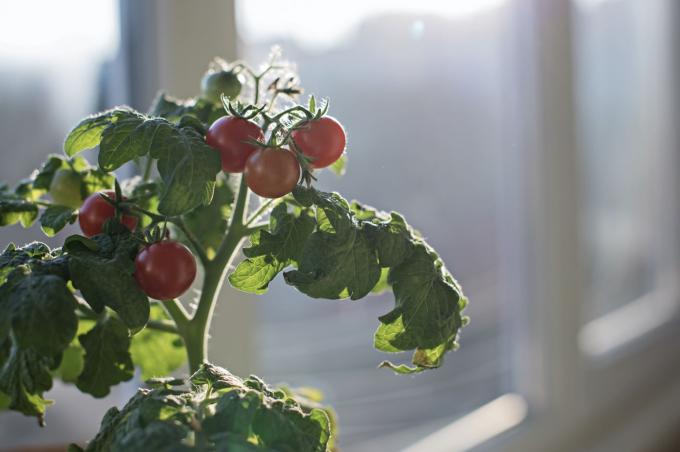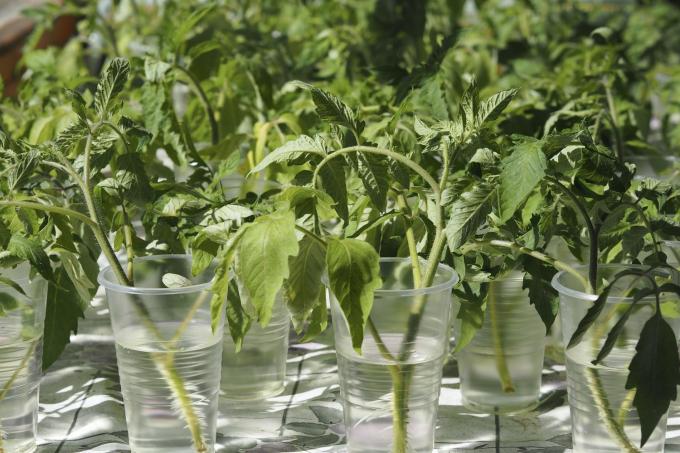The tomato plants that are perennial in their homeland can be overwintered with a lot of skill and a little luck. Here you can find out what to look out for when overwintering tomato plants.

As soon as the cold season approaches, the question arises for many hobby gardeners whether tomatoes can be overwintered. We get to the bottom of the subject and give you tips on how to overwinter tomato plants.
"Contents"
- Are tomatoes perennial?
- Hibernate tomatoes in a pot
- Hibernate tomato offshoots
Are tomatoes perennial?
The tomato (Solanum lycopersicum) originally comes from South America and their wild relatives, which grow like a bush, are also perennial in their warm homeland and are also relatively cold-tolerant. However, it looks a little different with our cultivated and harvest-bred tomatoes. It needs extremely warmth, is hardly tolerant of the cold and grows elongated instead of bushy and woody. There are no hardy tomato varieties for our temperate latitudes and the cold winters. Temperatures below 10 ° C damage the plants, cause leaves to die off and lead to symptoms of deficiency such as a purple coloration of the foliage due to a lack of phosphorus.
The right winter quarters for tomatoes should be as bright and warm as possible, the plants should be completely healthy when they are winterized. It is not without reason that the sun-loving plants are usually sown anew every year: Often, tomato diseases such as these gather by the end of the season in October and November Late blight and brown rot (Phytophthora infestans), the plants there. Only completely healthy and well-nourished plants can be successfully overwintered. In addition, the choice of variety is crucial when wintering tomatoes. Small, determined tomatoes and wild tomatoes can easily be wintered as a whole plant. When moving into the winter quarters, around half of the plant must be cut back in order to adapt evaporation and light requirements to the dark season. But don't worry: numerous new side shoots form over the winter, which in turn will bear flowers and fruit in the next summer.
Tall-growing stake tomatoes cannot be winterized as a whole plant; for them it is advisable to cut cuttings from the shoot tips. Hibernating tomatoes is more time-consuming than sowing them again - if the lighting conditions, water supply and temperature are right, it can still be successful.

Summary: can tomatoes be overwintered?
- Tomatoes are generally perennial and can be overwintered.
- The prerequisite is that the plants are absolutely healthy.
- Wintering is only possible in warm, very bright locations and with suitable varieties or by using cuttings.
- While the tomato can form flowers during the winter, these should be removed as the fruits cost the plant too much energy.
Tip: Why can't you harvest tomatoes in winter?
For our supermarkets, tomatoes are produced all year round in warm locations in high-tech, heated greenhouses with strong additional lighting. In fact, tomatoes do not hibernate - if the conditions are right, they will continue to bloom and keep fruiting. Production is only worthwhile in warm countries with mild winters, because there a lower temperature difference to the outside air has to be compensated for. Under normal "living conditions" in cold Germany, good growth conditions for tomatoes are hardly achievable - or a disproportionately large amount of energy is wasted.
Hibernate tomatoes in a pot
If tomatoes are to be overwintered successfully, robust wild tomatoes such as Humboldt tomatoes (Solanum humboldtii) or Currant tomatoes (Solanum pimpinellifolium). Also the already branched, small and determined bush tomatoes like ˈTiny Timˈ or Vilmaˈ are suitable for this. In order to overwinter whole plants in pots, they should have already been cultivated in pots beforehand - the plants cannot survive transplanting from the bed into a pot. Wild tomatoes can be cut back by half before overwintering because they branch out next spring again very well and also bear plenty of the many side shoots Fruit. You shouldn't cut bush tomatoes at all before winter.
The pots with the tomato plants should be set up from mid to late October in as bright a place as possible at 15 to 20 ° C. To overwinter tomato plants, they have to be well fed and healthy. A final fertilization in August and September before the transfer to the winter quarters ensures a good nutrient balance. Only very bright locations are suitable, for example winter gardens. A mirror can be placed behind the plants on south-facing windows to improve the light supply. Heated greenhouses are ideal, because here the light output is maximum - unfortunately the energy requirement is extremely high, which is why they are not recommended.

Overwintered tomato plant forms long shoots: what to do
The plant tries to compensate for the reduced supply of light by rotting and the formation of many side shoots. These bright shoots should therefore not be removed. However, you should regularly check them for pests as they are susceptible to them.
But if extremely light, thin and unstable shoots form, this is a sign that there is not enough light. A different location should therefore be sought or additional exposure should be provided. Looking for a lighter spot is of course always the cheapest and most sustainable option. For the exposure, special plant lamps are suitable, which, in contrast to normal lamps, offer a light spectrum tailored to plants. However, this type of overwintering is not very sustainable, even if LEDs can be used.
Hibernating cuttings, which we will introduce below, is less energy-intensive. Watering should be carried out sparingly in winter and regularly watered again from March onwards during the wintering period until planting in the following May. From spring you should also fertilize again.
tip: During the entire winter period, but especially from February and March, watch out for a possible pest or disease infestation. Pests should be combated as quickly and efficiently as possible, and infected parts or entire plants should be disposed of quickly.

Hibernate tomato offshoots
A good and space-saving alternative to overwintering whole tomato plants is the production of cuttings. Tomato offshoots are easier to overwinter: They are smaller, so more likely to be satisfied with a window seat and, in case of doubt, only need a small lamp. To do this, cut only 10 to 15 centimeters long shoot tips from healthy and well-nourished plants and leave them in the water or in a moist growing medium such as ours Plantura organic herb & seed compost, root at around 20 ° C. After about a week, the first new roots will appear and after transplanting into more nutrient-rich potting soil, the cuttings usually grow quickly. So that the plants do not grow too strongly, the nutrient supply should be a slowly flowing organic fertilizer like ours Plantura organic tomato fertilizer take place. Overall, you should only fertilize sparingly in winter.
Of course, tomato offshoots also have to be checked regularly for pests. From the middle of May the plants can move outside again, where they bear fruit particularly early due to their growth advantage.
This is much easier than with tomatoes Overwintering of Physalis. The edible lantern flower can survive the cold season in winter quarters and bear fruit early in the following year.
